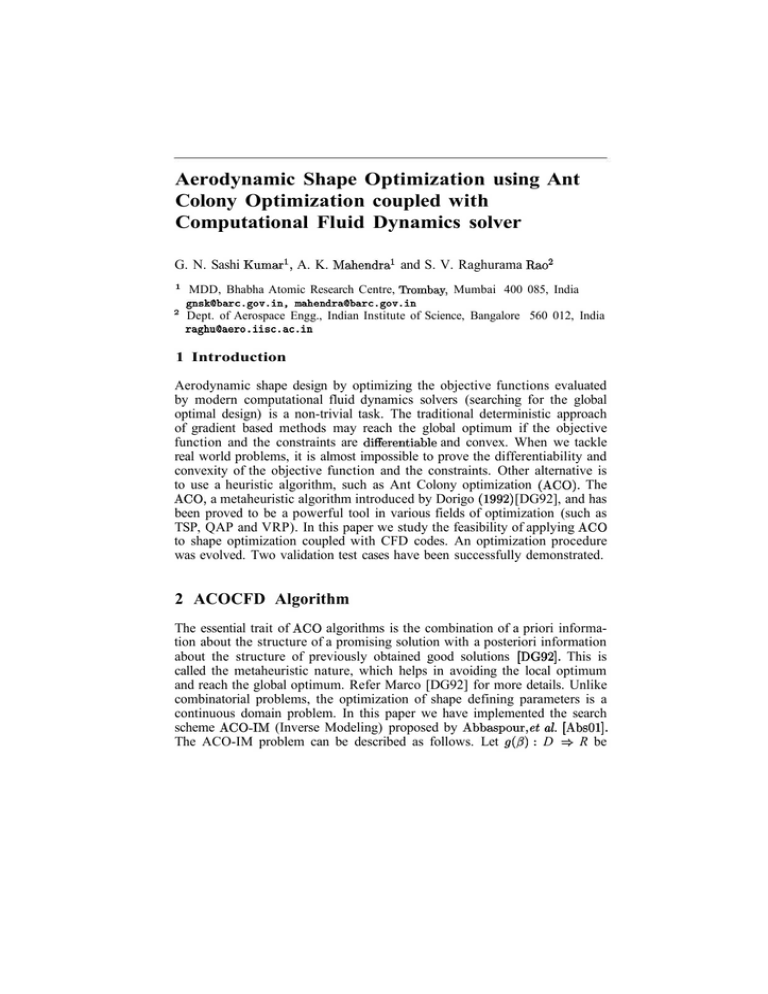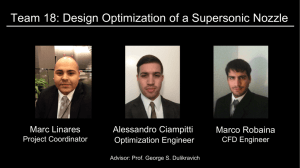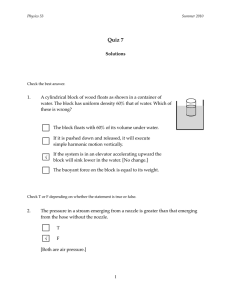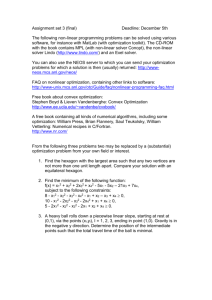Aerodynamic Shape Optimization using Ant Colony Optimization coupled with
advertisement

Aerodynamic Shape Optimization using Ant Colony Optimization coupled with Computational Fluid Dynamics solver G. N. Sashi Kumar1, A. K. Mahendra1 and S. V. Raghurama Rao2 1 2 MDD, Bhabha Atomic Research Centre, Trombay, Mumbai 400 085, India gnskObarc.gov.in, mahendraQbarc.gov.in Dept. of Aerospace Engg., Indian Institute of Science, Bangalore 560 012, India raghuQaero.iisc.ac.in 1 Introduction Aerodynamic shape design by optimizing the objective functions evaluated by modern computational fluid dynamics solvers (searching for the global optimal design) is a non-trivial task. The traditional deterministic approach of gradient based methods may reach the global optimum if the objective function and the constraints are differentiable and convex. When we tackle real world problems, it is almost impossible to prove the differentiability and convexity of the objective function and the constraints. Other alternative is to use a heuristic algorithm, such as Ant Colony optimization (AGO). The AGO, a metaheuristic algorithm introduced by Dorigo (1992) [DG92], and has been proved to be a powerful tool in various fields of optimization (such as TSP, QAP and VRP). In this paper we study the feasibility of applying AGO to shape optimization coupled with CFD codes. An optimization procedure was evolved. Two validation test cases have been successfully demonstrated. 2 ACOCFD Algorithm The essential trait of AGO algorithms is the combination of a priori information about the structure of a promising solution with a posteriori information about the structure of previously obtained good solutions [DG92]. This is called the metaheuristic nature, which helps in avoiding the local optimum and reach the global optimum. Refer Marco [DG92] for more details. Unlike combinatorial problems, the optimization of shape defining parameters is a continuous domain problem. In this paper we have implemented the search scheme ACO-IM (Inverse Modeling) proposed by Abbaspour,et al [AbsOl]. The ACO-IM problem can be described as follows. Let g(/3) : D => R be 2 G. N. Sashi Kumar, A. K. Mahendra and S. V. Raghurama Rao a continuous and bounded function and /? be a ^-dimensional state vector, where R be real numbers and D the search space of /?. The objective is to find the state vector /3 that minimises the objective function (OF) or g(/3). Since Fig. 1. Schematic of AGO coupled CFD solver AGO has been developed for ordered problems, its application to a continuous problem requires first discretization, of the search space D. The range of each parameter is discretized into finite number of levels. Ants are allowed to choose their paths among these discretized levels. Each ant path represents a shape. The schematic of the procedure is shown in Fig.l. 3 Aerodynamic Shape Optimization This section includes two cases namely, 1)A subsonic-supersonic nozzle with in the supersonic zone and 2) a nozzle without any shock (2D flow). In both the cases, nozzle parameterization requires generating a curve which represents the radius vs. length of the nozzle. This curve has been parameterized into: (l)inlet radius(-Rj), (2)control point(ai), (3)control point (0:2) and (4)outlet radius (R0). The curve is obtained by plotting 2 quadratic Bezier curves as shown in Fig.2. The throat radius is a fixed value. The shape of the nozzle has been taken as symmetric along its axis. The problem approach chosen is Inverse design optimization, where the target pressure profile (along centre of the nozzle) is made available. The objective of optimization is to match the target pressure profile so that target shape is simultaneously achieved. The objective function (OF) is defined as, L fP \2 ( p T - 1 . ) -dx / ..=o \pt ) where Pi and Pt are the current and the target pressure distribution. (1) Aerodynamic Shape Optimization using AGO coupled with CFD solver 0.0 0.5 1.0 1.5 Length (m) 2.0 2.5 3.0 Fig. 2. Parameterization of the nozzle shape 3.1 Design Case 1: Nozzle with shock The target pressure profile is that defined for a nozzle that is generated by following the distribution y(x) = 6.13288- 6.46404o: + 1.69043o:2 +0.326925o:3 - 0.061127o:4, where y(x) is the radius for a nozzle at a specified length, x. Here x £[0,3]. We now reconstruct this nozzle using AGO - CFD solver. An explicit MacCormack technique [Jda95] with quasi one-dimensional flow equations was used as the CFD solver. Results and discussion for design case 1 We start by discretizing the initial range (guess) of the nozzle parameters into five levels. 125 ants are allowed to choose their paths among these discretized levels. Here each ant path represents a nozzle shape. Grid is generated for this nozzle shape and CFD solver computes the pressure profile (Pi). The CFD solver was run for a 10 decade fall in the residue. The scores for each discretized level are evaluated (procedure has been elaborated in [AbsOl]). The discretized levels with high scores are retained for the next iteration and rest removed, thus narrowing the range of each parameter. This procedure was repeated till the range for the parameters narrowed to three similar significant digits. Table 1 shows the initial and final ranges for all parameters. It takes 7 Table 1. Optimization of parameter domain parameter Ri ai a2 Ro initial range [ [ [ [ 5.5 1.0 1.0 5.5 , , , , 6.5 2.0 2.0 6.5 Final range ] [ 6.15472, 6.15856 ] ] [ 1.1492, 1.1494 ] ] [ 1.2497, 1.2498 ] ] [ 5.8532, 5.8526 ] G. N. Sashi Kumar, A. K. Mahendra and S. V. Raghurama Rao Average OF — — — - Standard Deviation OF Minimum OF 10- 1 o1 Fig. 3. Change of Objective Function with iteration Fig. 4. Variation of pressure profile with iteration iterations (i.e. 125x7 CFD calls, about 3.1 hours on Pentium-4 at 3GHz) for arriving at the optimal design with 6 decade fall in average Objective Function (Fig.3). The final solution corresponds to a pressure profile captured with high accuracy (OF = 4xlO~ 9 ) (Fig.4). 3.2 Design Case 2: Subsonic-supersonic nozzle The target pressure profile is that defined for a nozzle that is generated by following the distribution y(x) = 1.22635 - 1.28918« + 0.32825«2 +0.07320«3 - 0.01388o:4, where y(x) is the radius for a nozzle at a specified length, x. Here x e[0,3]. We now reconstruct this nozzle using ACO-CFD solver. The 2DLSKUM-NS solver [Akm03] with 2-dimensional flow equations is used as the CFD solver. A meshless solver, Least Square kinetic Upwind Method based Navier-Stokes (LSKUM-NS) method for two dimensional flow equations was used. LSKUM-NS makes use of least squares and KFVS scheme [Akm03]. We have developed LSKUM-NS code for computation of 2D laminar viscous Aerodynamic Shape Optimization using AGO coupled with CFD solver 5 flows. The code uses the least square discretization for spatial derivatives (2nd order) and 1st order explicit time marching scheme. Results and discussion for design case 2 The 2D LSKUM-NS solver was run for 3 decade fall of the residue. The pressure contours of a typical airfoil are shown in Fig. 5. 125 ants were used for optimization. It takes 6 iterations (i.e. 125x 6 CFD calls, about 124 hours) for arriving at the optimal design with 4 decade fall in average OF (Fig.6). Fig. 5. Pressure distribution for a typical 2D nozzle profile Average OF — — — - Standard Deviation OF Minimum OF I 'I Fig. 6. Change of Objective Function with iteration In the final solution, pressure profile was captured with good precision (OF = 2xlO~ 6 ) ( Fig.7). The initial and final range for parameters of optimization is given in Table 2 G. N. Sashi Kumar, A. K. Mahendra and S. V. Raghurama Rao Length ( m ) Fig. 7. Variation of pressure profile with iteration Table 2. Optimization of parameter domain parameter initial range Final range Ri [1.1 ,1.3] [ 1.22224, 1.22376 ] ai [ 0.2 , 0.4 ] [ 0.22848, 0.231552 ] [ 0.2 , 0.4 ] [ 0.2608, 0.261568 ] «2 [1.1,1.3] [ 1.164, 1.16656 ] Ro 4 Conclusions We have demonstrated that ACO-IM coupled with CFD solvers can capture the global optimal design in shape optimization problems. References [DG92] Dorigo, M.: Optimization, learning and natural algorithms. PhD Thesis, Politecnico di Milano, Milano (1992) website : http://iridia.ulb.ac.be/rhdorigo/ACO/ACO.html [Jda95] Anderson Jr., J.D.: CFD: The basics with applications. McGraw-Hill Inc.,(1995) [AbsOl] Abbaspour, K.C.ei al.: Estimating unsaturated oil hydraulic parameters using AGO. Advances in water resources, 24, 827-841 (2001) [D86] Deshpande, S.M.:Kinetic theory based new upwind methods for inviscid compressible flows. AIAA paper, 86-0275, (1986) [Akm03] Mahendra, A.K.: Application of LSKUM to strongly viscous rotational flow. MSc(Engg.) Thesis, Indian Institute of science, Bangalore (2003)





